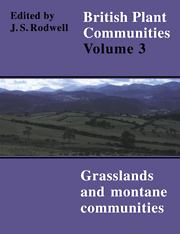Book contents
- Frontmatter
- Contents
- List of Figures
- Preface and Acknowledgements
- Preamble
- Mesotrophic Grasslands
- Community Descriptions
- Calcicolous Grasslands
- Community Descriptions
- Calcifugous Grasslands and Montane Communities
- Community Descriptions
- Index of Synonyms to Grasslands and Montane Communities
- Index of Species in Grasslands and Montane Communities
- Bibliography
MG6 - Lolium Perenne-Cynosurus Cristatus Grassland Lolio-Cynosuretum Cristati (Br.-Bl. & De Leeuw 1936) R.Tx 1937
Published online by Cambridge University Press: 04 July 2020
- Frontmatter
- Contents
- List of Figures
- Preface and Acknowledgements
- Preamble
- Mesotrophic Grasslands
- Community Descriptions
- Calcicolous Grasslands
- Community Descriptions
- Calcifugous Grasslands and Montane Communities
- Community Descriptions
- Index of Synonyms to Grasslands and Montane Communities
- Index of Species in Grasslands and Montane Communities
- Bibliography
Summary
Synonymy
Fatting Pastures and Dairy Pastures Stapledon 1925; First-Grade Ryegrass Pasture and Second-Grade Ryegrass Pasture Davies 1941 & 1952, Beddows 1967; Reverted Pasture Duffey et al. 1974; Ordinary dry meadows Ratcliffe 1977; Trifolio-Agrosto-Festucetum Evans et al. 1977 p.p.
Constant species
Cerastium fontanum, Cynosurus cristatus, Festuca rubra, Holcus lanatus, Lolium perenne, Trifolium repens.
Physiognomy
The Lolio-Cynosuretum generally has a short, tight sward which is grass-dominated. Lolium perenne is usually the most abundant grass with varying amounts of Cynosurus cristatus. In younger, re-sown grasslands, C. cristatus may be rare and, with good management, it generally remains a subsidiary species. With less intensive grazing, however, it may attain dominance and it is then especially conspicuous in winter by the abundance of its dead wiry flowering stems. Festuca rubra and Agrostis capillaris are frequent throughout and, in longestablished pasture, they may be abundant. Holcus lanatus and Dactylis glomerata are also frequent but of somewhat patchy distribution. They may become more prominent as coarse tussocks if pasture is under-grazed and H. lanatus is often abundant and vigorous around cattle dung which the animals avoid. Poa pratensis and P. trivialis are the only other grasses frequent throughout.
The dicotyledonous component of the sward is rather unvaried in its composition but individual species may be prominent in particular stands. The most frequent and abundant species overall is Trifolium repens which often attains co-dominance with L. perenne in wellmanaged swards. Cerastium fontanum, Plantago lanceolata, Ranunculus acris, Achillea millefolium and Bellis perennis are also frequent but generally at low cover. Diversity may be increased by the persistence of meadow species where the community has been derived from such grasslands as the Centaureo-Cynosuretum or by the occurrence of a variety of ephemerals alongside footpaths, around gateways or on patches of bare soil exposed by poaching. Bromus hordeaceus ssp. hordeaceus, Medicago lupulina, Trifolium dubium, Poa annua and Hordeum murinum may be locally abundant in such situations. Tall herbs are generally rare but Urtica dioica, Heracleum sphondylium and Anthriscus sylvestris may be prominent where there is soil eutrophication and disturbance around gateways or along field margins.
- Type
- Chapter
- Information
- British Plant Communities , pp. 67 - 73Publisher: Cambridge University PressPrint publication year: 1992

